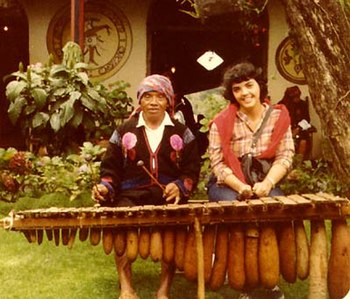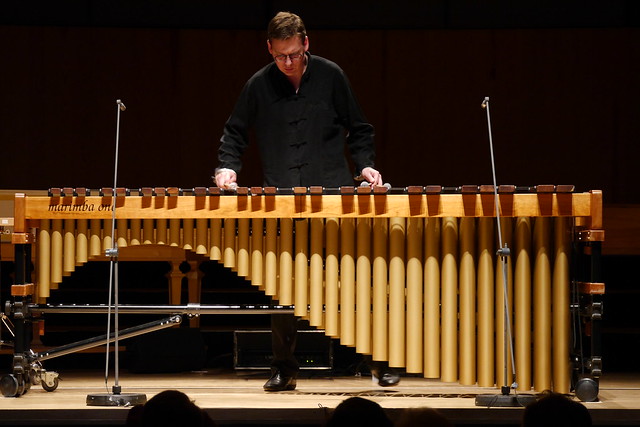 |
| Folk marimba with gourds, Highland Guatemala (Photo credit: Wikipedia) |
Other instruments in the percussion family include such instruments as cymbals, chimes, the triangle, bells, to name just a few. The marimba is a pitched percussion instrument. Other pitched percussion instrument examples include the timpani, the vibraphone, the glockenspiel, and chimes
Marimbas are used mainly for 20th Century music orchestral music, usually, as a sound effect or as a solo instrument. The marimba actually had long solos in the soundtrack to the film American Beauty.
The marimba keys are arranged like the keys of a piano and they may have as many as 4 - 5.5 octaves of professional Orff-style marimba bars. The bars are tapped to play the notes, similar to the xylophone. Marimba bars are finely crafted from hardwoods such as rosewood, mahogany and padouk. The keys are fine-tuned to reflect the tones played in African societies.
For marimbas in the United States, the resonators under the wooden bars are usually metal and most likely aluminum. They are hollow metal pipes of different lengths with holes covered by thin cellophane (similar to the West African balafon). This is so that when the marimba is struck, you can hear the buzzing sound characteristic of these instruments.
The mallets generally have wooden shafts but may be made of fiberglass, as well. Rattan shafts are also available and they have a little bit of "give" to them while other materials do not. Depending on training and preference, a marimbist may like the flexible shaft better than the ones with no "give" or vice versa. The material that actually strikes the key is usually some type of rubber wrapped in yarn. The marimba keys themselves will define which type of mallet is used on which part of the keyboard. The harder mallets are usually used to strike the high notes and the softer mallets for the lower notes. This is particularly important in playing the marimba because a mallet that is too hard for the keys it strikes may damage the instrument.
Most marimba music calls for several mallets to be used in one composition. It is not uncommon to find 2-3 players stationed at the marimba during a performance. Because two or three people will wield four to six mallets, it is possible to hear beautiful chords coming from the instrument. Many marimba players also play with more than one mallet in each hand. Different methods have also been developed to hold the mallets necessary for a piece of music in one hand. The Burton grip and the Musser-Stevens grip are the two common methods of gripping multiple mallets and each has its advantages and disadvantages.
The repertoires of bands in the United-States tend to overlap, probably due to the fact that most of the marimba music is composed by the Zimbabwean musician Dumisani Maraire. He is one of the key people who first brought Zimbabwean music to the West, moving to and working at the University of Washington in 1968. He was a master at playing an instrument known as the mbira which greatly resembles a small hand-held instrument known as the thumb piano.
A marimba is an expensive but beautiful instrument. Professional marimbas start in the $2,000 range for a used instrument. They add an open tone to many different compositions that make them very unique and sought after in the instrument family.
|


